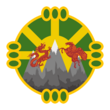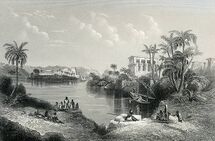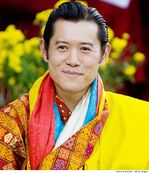Namdatka: Difference between revisions
No edit summary |
No edit summary |
||
| Line 136: | Line 136: | ||
Namdatka exists as one of the earliest continuosly inhabited regions on [[Eurth]], with the earliest discoveries dating back to the {{wp|neolithic era}}. The [[Nyingma culture]] was the earliest emergence {{wp|Sino-Tibetan languages|Trans-Careleon}} culture which appeared early in Namdatka's history and originated from central Europa. In it's earliest years, Namdatka existed as a decentralised grouping of individual dry valley civilisations. Namdatka was heavily influenced by the spread of Buddhism that occurred during the life of {{wp|The Buddha|Vuatama Buddha}} (Shakyamuni Buddha in Drukkha) during the 6th century BC. For a short time, Namdatka was united under the [[Aayan Empire]] during the Iron Age. Following the empires collapse, Namdatka returned to it's diverse and separate valley civilisations. In large part the nation was split into two, the Gyeltshen Dynasty to the west and the Mongar River Valley Civilisations in the east. The state was centralised in 1003 AD, under the [[Samtese Empire]], where it remained until occupation from the [[Mahana|Kingdom of Mahana]]. During these years Namdatka saw change to it's demography as large numbers of Mahanan prisoners and criminals were transported to Namdatka to work on {{wp|rice paddies}} which introduced a generally large minority of [[Mahanans]]. This changed during the 17th and 18th centuries as a period of Namdatkan nationalism arose around their separate identity and connection to the [[Careleon Plateau]]. This resulted in the [[Namdatkan People's Revolution]] of the late 18th century which was a success due to Mahanan troops occupied in a war with [[Mekabiri]]. | Namdatka exists as one of the earliest continuosly inhabited regions on [[Eurth]], with the earliest discoveries dating back to the {{wp|neolithic era}}. The [[Nyingma culture]] was the earliest emergence {{wp|Sino-Tibetan languages|Trans-Careleon}} culture which appeared early in Namdatka's history and originated from central Europa. In it's earliest years, Namdatka existed as a decentralised grouping of individual dry valley civilisations. Namdatka was heavily influenced by the spread of Buddhism that occurred during the life of {{wp|The Buddha|Vuatama Buddha}} (Shakyamuni Buddha in Drukkha) during the 6th century BC. For a short time, Namdatka was united under the [[Aayan Empire]] during the Iron Age. Following the empires collapse, Namdatka returned to it's diverse and separate valley civilisations. In large part the nation was split into two, the Gyeltshen Dynasty to the west and the Mongar River Valley Civilisations in the east. The state was centralised in 1003 AD, under the [[Samtese Empire]], where it remained until occupation from the [[Mahana|Kingdom of Mahana]]. During these years Namdatka saw change to it's demography as large numbers of Mahanan prisoners and criminals were transported to Namdatka to work on {{wp|rice paddies}} which introduced a generally large minority of [[Mahanans]]. This changed during the 17th and 18th centuries as a period of Namdatkan nationalism arose around their separate identity and connection to the [[Careleon Plateau]]. This resulted in the [[Namdatkan People's Revolution]] of the late 18th century which was a success due to Mahanan troops occupied in a war with [[Mekabiri]]. | ||
Once independence was gained, a new reformed government was reformed aroud [[Khasa]] | Once independence was gained, a new reformed government was reformed aroud [[Khasa]] and theongkhapa. At first, Namdatka was weakened by infighting between eastern and western noble groups, those that were loyal to the previous Rai monarchy in the west felt subdued by the new monarchy. These people were targeted by [[Namdatkan Modernisation]] campaigns, leading to the [[Troubles in Tenchwa]]. The {{wp|caste}} was officially abolished in the early 20th century however the remnants of the system remain in Namdatkan society. Namdatka is notable for it's isolationism and rejection of westernised cultural ideals due to it's isolate location, having a unique governmental structure and only officially adopting a national flag in 1955. Despite this, in modern times the country has become less isolationist and branched out to have relations with [[Zekistan]], [[Mahana]], [[Mekabiri]] and [[Chyrcassia]]. They are also a full member of the [[Assembled Nations]]. | ||
==Etymology== | ==Etymology== | ||
| Line 204: | Line 204: | ||
}} | }} | ||
( | In accordance with the 1989 {{wp|constitution}}, which is considered to be the foundation of the modern Namdatkan state, the country is a {{wp|Constitutional monarchy|constitutional monarchy}}, although one with a complex traditional system with the Tsongkhapa exerting significant levels of power and authority. Namdatka has had a Tsongkhapa (the monarch) since it's days of independence from Mahana, with individually city-states and kingdoms having a Tsongkhapa long before. In 1989 a new reformed parliament was formed with an elected Lyonchhen (President) being elected into office to serve under the monarch as an advisor. | ||
==Economy== | ==Economy== | ||
Revision as of 21:27, 19 May 2023
Tsongkhapan of Namdatka | |
|---|---|
| Motto: ྕེང ཆགཅཆཙག ཙོཡག ེལོིགད Our people stand united. | |
| Anthem: ྀཐཏཁཏ ཐེཤ Tsawa Sum | |
 Map of Namdatka | |
| Capital | Khasa |
| Official languages | Drukkha |
| Recognised regional languages | Mahanan, Zekistani |
| Demonym(s) | Namdatkan |
| Government | Unitary parliamentary semi-constitutional monarchy |
• Tsongkhapa | Tshering I |
• Lyonchhen | Kundang Ladakh |
| Population | |
• 2018 census | 876,498 |
| Currency | Namdatkan ngultrum |
| Date format | mm/dd/yy |
| Driving side | left |
| Internet TLD | .nd |
This article is incomplete because it is pending further input from participants, or it is a work-in-progress by one author. Please comment on this article's talk page to share your input, comments and questions. Note: To contribute to this article, you may need to seek help from the author(s) of this page. |
Namdatka (Drukkha: ཨཿོམེ་ཨོཕ༹་ཐེ་ཊིབེཏ་, Mahanan: नाम दत्तको राज्य), officially the Tsongkhapan of Namdatka, is a landlocked sovereign state in east-central Orient. It shares land borders with Mahana and Zekistan to the east and Chyrcassia to the west, as well as closely to Mantella in the west. Namdatka is located entirely within the Careleon Plateau and entirely landlocked. The country has a population of around 870,000. The capital is Khasa, but other large metropolitan areas include Dolka, Khedrup and Gonpo.
Namdatka exists as one of the earliest continuosly inhabited regions on Eurth, with the earliest discoveries dating back to the neolithic era. The Nyingma culture was the earliest emergence Trans-Careleon culture which appeared early in Namdatka's history and originated from central Europa. In it's earliest years, Namdatka existed as a decentralised grouping of individual dry valley civilisations. Namdatka was heavily influenced by the spread of Buddhism that occurred during the life of Vuatama Buddha (Shakyamuni Buddha in Drukkha) during the 6th century BC. For a short time, Namdatka was united under the Aayan Empire during the Iron Age. Following the empires collapse, Namdatka returned to it's diverse and separate valley civilisations. In large part the nation was split into two, the Gyeltshen Dynasty to the west and the Mongar River Valley Civilisations in the east. The state was centralised in 1003 AD, under the Samtese Empire, where it remained until occupation from the Kingdom of Mahana. During these years Namdatka saw change to it's demography as large numbers of Mahanan prisoners and criminals were transported to Namdatka to work on rice paddies which introduced a generally large minority of Mahanans. This changed during the 17th and 18th centuries as a period of Namdatkan nationalism arose around their separate identity and connection to the Careleon Plateau. This resulted in the Namdatkan People's Revolution of the late 18th century which was a success due to Mahanan troops occupied in a war with Mekabiri.
Once independence was gained, a new reformed government was reformed aroud Khasa and theongkhapa. At first, Namdatka was weakened by infighting between eastern and western noble groups, those that were loyal to the previous Rai monarchy in the west felt subdued by the new monarchy. These people were targeted by Namdatkan Modernisation campaigns, leading to the Troubles in Tenchwa. The caste was officially abolished in the early 20th century however the remnants of the system remain in Namdatkan society. Namdatka is notable for it's isolationism and rejection of westernised cultural ideals due to it's isolate location, having a unique governmental structure and only officially adopting a national flag in 1955. Despite this, in modern times the country has become less isolationist and branched out to have relations with Zekistan, Mahana, Mekabiri and Chyrcassia. They are also a full member of the Assembled Nations.
Etymology
(WIP.)
History
Prehistory
First settled by early expansions of hominins out of Azania into the prehistoric Orient date back at least 1.2 million years ago based upon traces discovered in the Goenpa Valley. The first homo sapien fossils date back to around 70,000 years ago and are some of the eldest traces of anatomically modern humans outside of Azania. The Nyingma culture was an early sedementary-based culture that is a predecessor to the modern Trans-Careleon and find their origins in central Europan steppes.
Drukkha Migration
WIP.
Gyeltshen Dynasty
WIP.
Religious Tension
WIP.
Rai Monarchal Period
During the 15th and 16th centuries Namdatka's eastern regions, especially around the city of Lwhang Tenchwa, existed a monarchy that grew out of the ancient Gyeltshen Dynasty that ruled over the realm it called Tsheringa. This monarchy made claim to an area of around 98,000 km2, containing around 90,000 people at the time. The land was arid and dry, leading to a majority of the population being situated around the Penden River in settlements around Lwhang Tenchwa. The Rai Monarchy ruled this kingdom with an iron-fist, however it flourished in comparison to the eastern regions at the time, which were under the subjugation of Mahana.
The monarchy continued its existence up until the foundation of Namdatka in 1780, where they joined the Union of Namdatka in exchange for Namdatka taking up the Rai Monarchy. This was what lead to the royal family of Namdatka being a part of the minority Ramarchops ethnic group.
War for Independence
The end of the 18th century was a time of great religious struggle in neighbouring Mahana. A movement arose with the native Namdatkan people group living in Mahana. This eventually led to a diplomatic feedback loop, which slowly turned into an escalated conflict.
The revolution began on the 6th May 1780, with uprising beginning in the city of Khasa. It initially was met with resistance from the Mahanans however due to struggles within the rest of the country the decision was made to grant the nation their independence only a month after, on the 17th June 1790. The war, despite being short-lived, lead to independence which lasts into present day.
Contemporary History
(WIP. Look at neighbours Mahana and Mantella.)
Geography
Climate
The climate is severely dry nine months of the year, and average annual snowfall is only 46 cm due to the rain shadow effect. Eastern passes and regions receive small amounts of fresh snow and occasionally rain throughout the course of the year. Low temperatures are prevalent throughout these eastern regions, where bleak desolation is unrelieved by any vegetation bigger than a low bush, and where the wind sweeps unchecked across vast expanses of arid plain. The Oriental Narope Rains have influence on its eastern regions, with some years having a much higher average rainfall than others.
(WIP. Landscape. Climate.)
Politics
Government
In accordance with the 1989 constitution, which is considered to be the foundation of the modern Namdatkan state, the country is a constitutional monarchy, although one with a complex traditional system with the Tsongkhapa exerting significant levels of power and authority. Namdatka has had a Tsongkhapa (the monarch) since it's days of independence from Mahana, with individually city-states and kingdoms having a Tsongkhapa long before. In 1989 a new reformed parliament was formed with an elected Lyonchhen (President) being elected into office to serve under the monarch as an advisor.
Economy
(WIP. Employment. Exports. Energy. Transport. Media. Currency.)
Demographics
Ethnic Groups
(WIP. Ethnic groups. Language. Religion. Health. Education.)
Cultures
(WIP. Literature. Visual arts. Music. Cuisine. Sport.)





